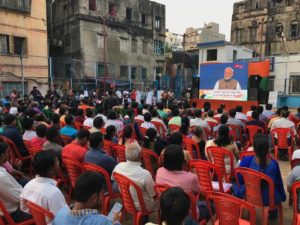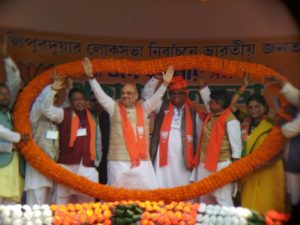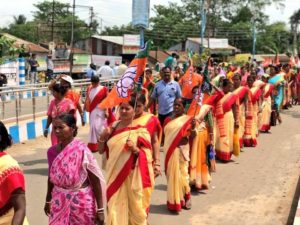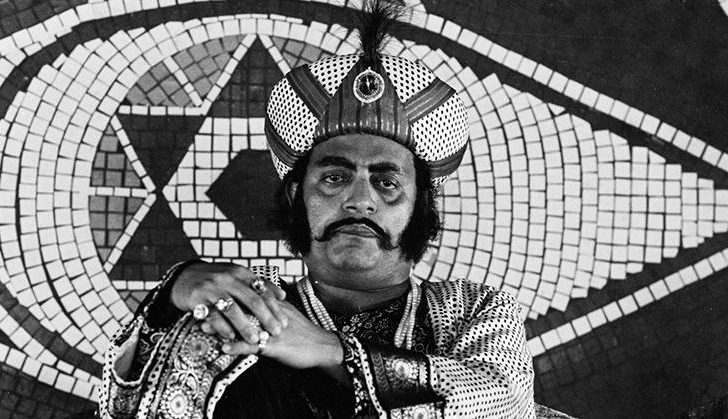Hirak Rajar Deshe (literal translation ‘In the land of the Diamond King’; English title: Kingdom of Diamonds, 1980) by Satyajit Ray is a prescient dystopian satire about state repression that was produced – quite remarkably, going by our recent times – by the Government of West Bengal, led by the Communist Party of India (Marxist) / CPI-M Chief Minister Jyoti Basu.
In the film the Hirak Raja (The Diamond King) had invested in a wizard-like gobeshok (scientist researcher) who invented a sinister machine Jantar-Mantar that could brainwash the dissenting subjects with whatever the king wanted them to believe and propagate.
Under the instruction of the king, the court poet wrote specific jingoistic limericks for specific groups – such as farmers, diamond miners, musicians and teachers – which were fed into minds of the subjects through the brainwashing machine.
This mogoj dholai (brainwashing) machine turned dissenters into supporters, changed their intrinsic nature and suppressed their critical-thinking ability. They blindly parroted whatever jingoistic propaganda that was fed into their minds. They also began to believe that the king was god and propagated the same to the others.
Going by the cantankerous modern-day jantar-mantar of the partisan mainstream news channels, one would think that the Bhartiya Janata Party (BJP) will become the main opposition party to the Trinamool Congress (TMC), win over 20 Lok Sabha (LS) seats in 2019 General Elections and increase its vote share to over twenty-five percent in Bengal.
Beyond the regurgitation of the lapdog media, even the consensus in the non-partisan press / print – whatever remains of it – is echoing a similar story of an imminent saffron surge.
How realistic is this claim? Is Bengal – that never suffered a right wing government in her post-Independence history – witnessing an unprecedented surge of saffron sentiments?
Has 1 in 4 voters in Bengal discovered a new character, a new sense of self and a new identity?

***
Statistics tell us at the height of ‘UPA II anti-incumbency’ and the ‘PR firms driven marketing magic’ of ‘Modi Wave’ of 2014, the voting percentage of the BJP in Bengal went up to a record high of 16.8%, translating into 2 Lok Sabha seats out of 42.
This rise to nearly 17% was a remarkable leap compared to the BJP’s single digit vote-share in 2004 and 2009 General Elections: 8% and 6%.
Then in 2016 Assembly Elections, the ‘Modi Wave’ went flat: the voting percentage of the BJP fell sharply to 10.2%, translating into 3 assembly seats out of 294 – its highest tally since Jan Sangh’s tally of 9 in 1952.
However, since 2016, in certain Assembly by-poll elections, the vote share of the BJP in few constituencies did go up and it did finish second behind the TMC in Maheshtala Assembly by-election. The BJP also secured about 18% of the contested gram panchayat seats in 2018.
In spite of gaining a wider-than-before acceptance in Bengal, the BJP still has to import workers and supporters from the neighbouring states to fill-up their rallies, processions and sieges. And this sustains a public perception that the BJP is a party of ‘outsiders’ who are not from the soil of Bengal, and hence doesn’t understand or represent the idealised culture of Bengal: liberal, plural, egalitarian, shakti worshipping, socialist and non-vegetarian.
***
Even the socio-cultural engineering efforts of RSS-BJP-Hindutva brigade to impose the alien North Indian Hindi-Hindutva-Hindustani culture on Bengal: popularise Ram Navami rallies with swords & trishuls and challenge the thousand-year-old shakti worshipping tradition by promoting patriarchal male gods haven’t yielded the desired results. And the failure to get any cow-belt-like traction has even forced the Hindutva social media trolls to use Jai Maa Kali and Jai Maa Durga, rather than Har Har Mahadev and Jai Shri Ram.
But the well funded RSS – with its messianic drive to convert all Hindus to Hindutva – has spread its roots in Bengal during the past five years via the proliferation of RSS linked schools. BJP is also determined to grow in Bengal from where Jan Sangh (Bharatiya Jana Sangh) founder S.P. Mookerjee hailed. And it was also the Bengalis – Abanindranath Tagore and Bankim Chandra Chatterjee – who have contributed to the creation of the popular chants of the Sangh Parivar: Bharat Mata Ki Jai and Vande Mataram.
(Ironically, Bharat Mata was originally painted in 1905 by Abanindranath Tagore as Bongo Mata – he initially wanted to name the water-colour painting as such to offer tribute to the quintessential Bengali woman.
Bankim Chandra Chatterjee also thought of Bengal, while writing the Bengali-Sanskrit poem Bande Mataram in his 1882 novel Anandamath.
Due to the tryst of time, these two iconic works of art and poetry have come to mean nationalism – linked not to Bengal – but to India)
***
A hidden – but a crucial – dimension of any elections nowadays is WhatsApp that has been weaponised as the instrument of political campaigning and psychological warfare. This free messaging application is the foremost source of radio-active fake-news and incendiary content that seeps under the radar – like stealth bombers – directly into our consciousness, via the ubiquitous smart phones.
The economy of Bengal is doing comparatively well as per the recent economic and social indicators. Hence, the Hindutva WhatsApp narrative in Bengal isn’t focussed much on economy and development, but is concentrating upon the glorification of the Prime Minister, smearing of the opposition and fomenting of communal polarisation.
The majority of people in Bengal are Hindus (70.54%), but the Hindutva WhatsApp hyper-narrative is that Bengal will turn to ‘another Kashmir’, and become ‘an Islamic / Muslim majority state’ where the ‘Hindus will be expelled like the Kashmiri Pandits’, unless the BJP comes to power.
How far can the BJP go by creating irrational anxieties, victim mentality, insecurities, hate and fear? Can a dark negative campaign of 2019 yield any result similar to the bright positive campaign – however deceptive – of 2014?
The BJP President Amit Shah – in his most recent campaign in Bengal – has promised to throw ‘infiltrators’ – read Muslims – out of Bengal and save ‘Bengal’s’ – read Hindu – culture.

The RSS-BJP perennially misunderstands Bengali culture. For them, a Hindu in Bengal is a Bengali while a Muslim in Bengal is a Bangladeshi. They don’t understand that a Bengali can be a Hindu, Muslim, Christian, Buddhist, agnostic or atheist. The culture of Bengal holds ‘bengaliness’ together, rather than mere religion.
***
The ‘terrorism-strikes-Pakistan’ driven hyper-nationalism hasn’t sustained in Bengal. The attempted spin: ‘either you are with Modi, or else you are an anti-national who distrusts the armed forces and supports Pakistan’ should be treated like it is: an illogical forced smear aimed at emotive manipulation that should scare no one.
The people in Bengal understand – and will be made to understand by the other parties – neither the BJP nor the Prime Minister is the armed forces. And the attempt to hide behind the armed forces to avoid answering discomforting pesky questions about Pulwama and Balakot is being judged as a sign of defence, rather than of attack.
The electoral bait of militarised nationalism is also getting blunted by a growing chatter about the episode that sparked it all – the Pulwama attack. More so because the BJP’s entire re-election campaign of 2019 – apart from communal polarisation – is totally focussed upon national security: terrorism, strikes, Pakistan and leadership / ‘chowkidarship’.
One wonders what would have been the BJP’s 2019 campaign if the Pulwama attack didn’t happen! How would the whipping of fear, threat, revenge and militarised nationalism have panned out in that case?
The TMC has promised a thorough investigation into demonetisation / note-ban in its election manifesto. Other probes – as promised in the Congress Manifesto – also need to happen, including Pulwama and Balakot.
***
The latest ‘surgical strike’ in outer space to demonstrate capability to down a live satellite hasn’t led to any surge of nationalism. It is rather seen as the continuing work of the scientific community being hijacked by a desperate Prime Minister for political posturing and election propaganda.
The BJP cannot really sell the virtues of their flagship economic initiatives – like demonetisation and GST – and has nothing much to boast about the 2014 campaign plank of ‘development’. Avoiding the real issues of the people, the BJP has latched on to self-defeating hollow stunts like pre-fixing Chowkidar to the names on social media and making #MainBhiChowkidar go viral when the actual record of the Modi regime – accused of the alleged Rafale scam – in dealing with corruption – especially of the ultra rich – is abysmal.
The loosening of the campaign finance laws in India by the Modi Government – use of opaque electoral bonds, legalising anonymous donations and allowing the murky shell companies to function as conduits – has virtually put our democracy on sale to the highest bidder and has allowed unprecedented influence of the corporate and foreign entities on our elections, and thereby, also on the policies of the elected government.
This is almost like the door towards potential corruption has been widely opened by the chowkidar; and the potential covert shady dealings have been legalised.
Hence, the ‘chowkidar stunt’ is causing more ironical laughs in Bengal and highlighting the absurd hypocrisy of the BJP when a local leader like Mukul Roy – tainted by the chit fund scam – has prefixed ‘chowkidar’ to his name on social media.
Apart from being a watchman against corruption, the BJP is now looking to take the ‘chowkidar’ metaphor to include more meanings – from a security watchman to a selfless public servant. But the dismal record of the Chowkidar Prime Minister – under whose watch the Pulwama attack happened, and who is known to be part of the ‘suit-boot-ka-sarkar’ instead of a genuinely pro-people public servant – totally contradicts the chowkidar image that is being sought to be constructed.
Things have come to such a sad situation that the twitter handle of ‘Chowkidar Narendra Modi’ sold saffron coloured ‘Main Bhi Chowkidar’ T-shirts for a public event.
Prime Minister of India peddling commercial merchandise via Twitter is a new low, even for Narendra Modi.
The recent observation made by the Patidar leader Reshma Patel – while she quit the saffron party – that the BJP has turned into a ‘marketing company’ that uses its workers and leaders for marketing its ‘hollow’ schemes, couldn’t have been more pertinent.
***
The other significant pre-election development in Bengal was the possibility of an alliance between the Indian National Congress and the Left Front. But ultimately, the alliance collapsed.
In 2014 General Elections the vote share of the Congress (9.58%) and the CPI-M (29.71%) added up to over 39%, when the vote share of All India Trinamool Congress (TMC) was 39.05% (translating into 34 LS seats).
In the 2016 Assembly Elections, the combined vote share of the Congress (12.3%) and the CPI-M (19.8%) fell to 32%, while the vote share of the TMC increased to over 44%, while the BJP had only secured 10.2%.
If the Congress- Left Front alliance went ahead, it could have posed a serious challenge to the TMC in a number of seats. But since the alliance has collapsed, the advantage of a 4-way contest will go to the TMC – which is a focal part of the opposition Mahagatbandhan – rather than the BJP.

***
The BJP’s talent base in Bengal is rather weak, just like its local leadership, and is dependent upon individuals who have been poached from other parties. It also struggled to find potential ‘winnable’ candidates for all the 42 LS seats. The 28 candidates announced in the first list didn’t spark any buzz, but rather, dampened many of the BJP supporters. Posters against the BJP candidates – by the BJP supporters – appeared in Malda and Basirhat. An irate mob of saffron supporters – unhappy with the choice of candidate who is allegedly involved in criminal activities – even ransacked the party’s district office in Cooch Behar, North Bengal.
Whatever the Hindutva forces have tried in the last five years – from trying to incite communal violence to the contentious ‘Save Bengal’ campaign – hasn’t crossed the threshold of making a widespread impact. The pro-Hindutva social media campaigns in 2017 about Tagore, Michael Madhusudan Dutta and ‘Matsya avatar fish’ backfired.
Ever since the Basirhat riots of 2018, the cyber crime department has also been quick to act against the Hindutva social media trolls who spread fake-news and incendiary content to incite communal tensions.
The BJP’s campaign in Bengal in the recent days has also failed to whip-up any momentum. The planned brigade rally in Kolkata in January 2019 featuring Prime Minister Narendra Modi was cancelled after the BJP lost the three Hindi heartland states to the Congress in December 2018. Even more significantly – thwarted by the TMC Government and the Supreme Court – the BJP couldn’t do the extremely ironical ‘Save Democracy’ Rath Yatra in Bengal by using pre-configured luxury buses from Uttar Pradesh.
The recent Brigade Rally in Kolkata by the Prime Minister Narendra Modi was marked by low turn-out and the famed orator appeared to be totally out of form.
In Bengal, the resistance to the right wing is deep rooted. The culture of the saffron heartland is an anti-thesis to the culture of Bengal. Yet there is a talk about a growing pool of silent BJP supporters who will swing some of the constituencies and spring few unexpected surprises. The BJP-RSS-Hindutva group has a lot of cash, resources and its jantar-mantar is on full volume. We will be able to judge their effectiveness, or the lack of it, on May 23, when the election results are declared.
The results will indicate whether – just like India – Bengal is truly facing an existentialist threat against the very idea of Bengal. They will also throw a light upon what might happen in Bengal’s next Assembly Elections in 2021.
But as a conclusion, I would go against the tide of chatter, and make a contrarian prediction about Bengal: the BJP will score in the range of 0-4 Lok Sabha seats. It might improve upon the vote-share of 10.2% – that it secured in the 2016 Assembly Elections – but is unlikely to surpass – what it had polled in 2014 General Elections – 16.8%.
The BJP national President Amit Shah has claimed that the party will win 23 LS seats in Bengal. But the way things have shaped up, the speculation of an impending BJP semi-sweep is more in the realm of wishful fantasy than of actual reality.
The Hindutva forces are posing a scattered challenge, but they are still far away, from any overall conquest.
The story of the BJP in Bengal has been more hype than substance. This is unlikely to change in the General Elections of 2019.
[The views expressed belong solely to the author, and may not reflect the opinions of the editorial team]


Comments are closed.